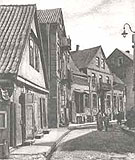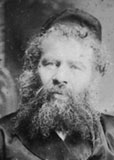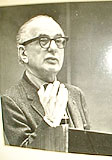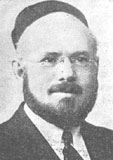All about YIVO
Day after day during a week of blizzards in February 1998, I was drawn back to
YIVO, having discovered the venerated Institute for Jewish Research
in the last of its interim quarters, far west on W. 57th Street.

The photo collection held me riveted, in particular the images of damage and
worse perpetrated during
pogroms, and one unforgetable photo of thugs ("pogromistas") en route to wreak
havoc.
I also looked for and found The American Jewish Year Book for 1907,
which has a horrifying table of pogroms from 1903 to 1906. Some of the worst
took place in Kishniev, Minsk, Kiev and
Bialystok (old street in ghetto shown at a quiet time).
Those are a few of the many locations listed, along with
details about the horrors that took place at each.
The Great Abramowicz
The librarian,
Dina Abramowicz, who had been part of YIVO in Vilna, still reigned in 1998,
then over YIVO's library as research librarian, where she would stay until her death
two years later at the age of 90. She graciously translated writing on the back of several
mysterious photos, offering insight into the Chasman
branch of our family.
Serendipity
There couldn't have been a better time to explore YIVO's holdings,
due to the absence of a certain lofty personage then unknown to me.
Happily, I was thus able to become acquainted with YIVO's Leo Greenbaum,
well versed in everything I wanted to learn or see, and where to find it. Three
years later, we met again in the reading room at the new Center for Jewish History, when
by chance, he happened to be on duty.
Fabulous library
After an absence of several years, the library compelled a visit to
see what I could discover about a great rabbi
 with
a tangential connection to
with
a tangential connection to
our family. Rabbi Willowski (right) was an uncle of Rose, who married Barnet Cohen of Toby's branch, and
his grandson, Ira Mintz, brought him to my attention. Barnet was "the learned
one" in the family, having completed Yeshiva before coming to America.
Barnet was also our major practicing HaKohen, said cousin Shirley Gelman,
whose mother, Minnie, was Barnet's sister.
What joy to find six major compendiums of rabbis, all of which included the
accomplishments of Rabbi Jacob David Ben Ze'ev Willowski. Alas, none
was in English.
Riches about yiches
There is also much by, and about, Rabbi Willowski's
grandson, Milton R. Konvitz (below at left, lecturing in the early
1970's). He is a Cornell
 law professor emeritus and
a well known constitutional
scholar. The United States Supreme Court has made reference to Milton's
published work no less than 16 times, said cousin Ira Mintz, who is an
attorney. During our telephone conversation, Ira had taken a look on Lexis-Nexis from his home computer.
law professor emeritus and
a well known constitutional
scholar. The United States Supreme Court has made reference to Milton's
published work no less than 16 times, said cousin Ira Mintz, who is an
attorney. During our telephone conversation, Ira had taken a look on Lexis-Nexis from his home computer.
Milton's father, Joseph Konvitz (photo below, right), had married one of Rabbi Willowski's
daughters, and went on
 to carve a distinguished career for himself as a rabbi. This trio of eminences is slated for a web page chapter in the section
entitled, "Have we got yiches!"
to carve a distinguished career for himself as a rabbi. This trio of eminences is slated for a web page chapter in the section
entitled, "Have we got yiches!"
Genealogical Packet for Future Generations
While
riches about the great rabbi and his constitutional scholar grandson piled
up on my reading table,
and the photocopying charges mounted,
I shared details of our family history's progress with archivist Greenbaum. This account included how our Uberstine history page developed, the CousinsPlus concept,
and newer projects, such as the Genealogical Packet for Future Generations (GPFG)
and its successor, the Teaching Packet for Future Generations (TPFG).
In an effort to "cap" the
endless project of
exploring our family history, I'd prepared a guide to what we have on
hand now, which would aid future generations as more records become
accessible. Called the GPFG, I distributed
it to whichever cousin in each
of our 18 branches most convincingly promised to hand down his/her copy to
his/her best-suited
descendant. The GPFG includes all our family names
through the first generation, in
Russian and in Yiddish, some maps, and examples of the types of historical data
available -- which we hope to
find some day about us Uberstines.
"Let me put this in our genealogical
collection," said Greenbaum, when I showed it to him.
Teaching Packet for Future Generations
As 2001 drew to a close, the first edition of a
more elaborate successor work -- "Teaching Packet for Future Generations" (TPFG)
-- reached Greenbaum's desk. The archival paper
used is touted
to last "for 500 years." But a spiral binding, which I prefer for my own use,
would be
unacceptable to this archival purist. And so the YIVO archives' version has its pages tied with a white satin ribbon. Like the spiral binding, this allows
for easily photocopying individual pages. The Uberstine collection also includes a
periodically updated CD of the web page, photographs and other printed
materials. It can
be viewed on request in the reading
room at the Center for Jewish History,
15 West 16th St., New York, NY 10011.
Two pages are online here:
Table
of Contents for the 2001 edition, and the latest version of "Who came from
where?"

![]()

 with
a tangential connection to
with
a tangential connection to  law professor emeritus and
a well known constitutional
scholar. The United States Supreme Court has made reference to Milton's
published work no less than 16 times, said cousin Ira Mintz, who is an
attorney. During our telephone conversation, Ira had taken a look on Lexis-Nexis from his home computer.
law professor emeritus and
a well known constitutional
scholar. The United States Supreme Court has made reference to Milton's
published work no less than 16 times, said cousin Ira Mintz, who is an
attorney. During our telephone conversation, Ira had taken a look on Lexis-Nexis from his home computer.
 to carve a distinguished career for himself as a rabbi. This trio of eminences is slated for a web page chapter in the section
entitled, "Have we got yiches!"
to carve a distinguished career for himself as a rabbi. This trio of eminences is slated for a web page chapter in the section
entitled, "Have we got yiches!"